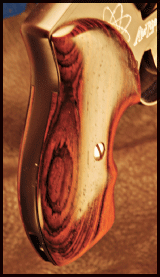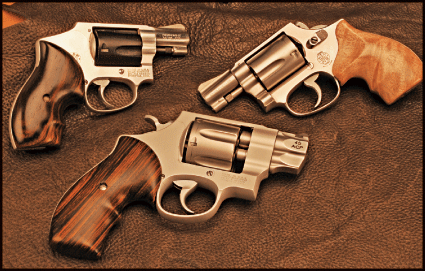We call it a “breakthrough” when an innovation surfaces that’s way ahead of anything comparable. That’s true in the gun business as much as any other. When he first made a special grip for his favorite concealed carry revolver, Oregonian Craig Spegel had no idea that he was making a breakthrough. That was over 30 years ago and Spegel has since quietly gone about the business of making the boot grip (as he calls it) for a few selected revolver models. Interestingly enough, he still makes them the same way, one pair at a time. Over the years, I have grown to be a hopelessly enthusiastic fan of this product. Any Smith & Wesson snub-nosed revolver without the Spegel boot grip is just not properly equipped for serious shooting. I have them on almost every short J-frame in my assortment, as well as a few K-, L-, and N-frames.
 That is a pretty powerful introduction, so I better explain myself. The boot grip is a pair of wooden grip panels inletted to precisely fit a round butt J-frame S&W. He also does a few to fit the larger round butt frames and a few square butts. In the past, Craig made occasional pairs for the Colt D-frame, but has discontinued those with the passing of that revolver.
That is a pretty powerful introduction, so I better explain myself. The boot grip is a pair of wooden grip panels inletted to precisely fit a round butt J-frame S&W. He also does a few to fit the larger round butt frames and a few square butts. In the past, Craig made occasional pairs for the Colt D-frame, but has discontinued those with the passing of that revolver.
As compared to the original grips issued with the Chiefs Special and Centennial revolvers, the boot grip differs in having a crescent-shaped filler block behind the triggerguard. This is hardly new, as similar devices were factory installed on various revolvers in the S&W line as far back as the 1930s. Many of the current production S&W J-frames come with very good grips that use this feature. Another relatively common revolver grip feature is finger grooves on the front face of the stock. Spegel uses a single finger groove on the boot grip. Other makers do many of these same things. So what is the big difference that causes me and many others to choose the Spegel product?
Advertisement — Continue Reading Below
Shootable Shape
In a word, it’s the shape. The boot grip is superbly contoured to facilitate fast, accurate, controlled shooting of a small concealable revolver. Some of these little guns are capable of accepting powerful cartridges, including the .357Mag. This means recoil, and lots of it. The gun has to be as shootable as possible, or the shooting may happen but will be neither fast, nor accurate nor controllable. Even with the old standby .38 Special (in its more powerful loadings), the recoil of an alloy frame 5-shot snubby is pronounced enough to be distracting. Properly shaped grips can help by distributing the recoil bump over more of the shooter’s hand and taking some of the sharp metal edges off the gun.
At this point in the discussion, another factor enters into the equation. No matter how effective it is, a proper grip for a concealed carry revolver should not interfere with the utility of the gun in the sense of complete concealability or speedy deployment. In other words, the grip should be compact and without edges, corners or other surfaces that could hang up on something in the process of presenting the handgun. Although this would seem to be a contradiction in which we are asking the grip designer to perform feats of magic, a boot grip on your favorite snubby pretty well establishes that it can be done. Craig Spegel’s boot grip adds nothing to the dimensions of the revolver. With the grip in place, the gun is no taller, longer, or thicker than it was right out of the factory box. Once installed, it makes the gun easier to carry, easier to draw, easier to fire and a hell of a lot more comfortable to work with. There are several features that make this happen, so let’s get right into them.
Coming Together
To begin with, the backstrap is exposed, but the wood of the two halves of the grip comes all the way up to the top of the frame. This is particularly important on the Centennial-style revolvers, which I am particularly fond of, because it provides a rounded contour. There is no exposed sharp corner to the frame that can dig painfully into the shooter’s hand at a sensitive point. 1950’s vintage Centennials had plain grips with a high horn that afforded the same protection, but so far, the company has been unwilling to put them back on the new DAO J-frames. Mostly, that’s because they can use one grip for all varieties of J-frame round butts: Chiefs Specials, Bodyguards and Centennials. Use of the upward extension is one of the biggest reasons that a Centennial is shootable with heavy loads because the recoil is spread over a greater part of the shooter’s hand. Also, since the grip is higher, the recoil comes more straight back into the shooter’s hand.
Advertisement — Continue Reading Below
The actual shape of the grip, as viewed from the rear, is another reason for better control. The grip has healthy palm swells on either side. They swell outward in the middle and come back in at the top and bottom to give the grip an almost lemon-like shape. This has the practical effect of increasing surface area on the grip and more contact surface means the recoil impulse goes to more of the hand. In similar fashion, Spegel works a single finger groove into the front of the grip. This one is high on the grip and accepts the longest, strongest, middle finger. It is the middle digit of the hand, working against the opposable thumb, which does the majority of the gripping of any object. Using a finger groove is another way to increase the distance from the top of the grip to the bottom. Again, this adds up to more contact surface and better control. A revolver fitted with Spegel’s boot grips shoots easier because the shooter holds it higher and that gives him better leverage against the trigger. The grip maximizes the contact area for the shooter’s hand and that provides an edge in absorbing recoil.
Aside from their great utility value, Spegel’s boot grips are very handsome. Spegel uses carefully selected hardwoods, usually cocobolo, walnut, myrtle or African blackwood, to build boot grips. They are meticulously cut by the craftsman in his small shop in an idyllic little town on the coast of Oregon. He also makes some of the very best grips you will ever find for 1911 and Browning Hi-Power pistols. You can find a selection of Spegel grips on Novak’s website. All of his work is outstanding, but the boot grip for little J-frames is nothing less than a latter-day masterpiece.
Check out this article about Cowboy Revolvers for Self-Defense!
Advertisement — Continue Reading Below
For more information contact: Novak Sights (Spegel Grips), PO Box 4045, Dept CH, Parkersburg, WV 26104; 304-485-9295; www.novaksights.com.
Advertisement — Continue Reading Below























